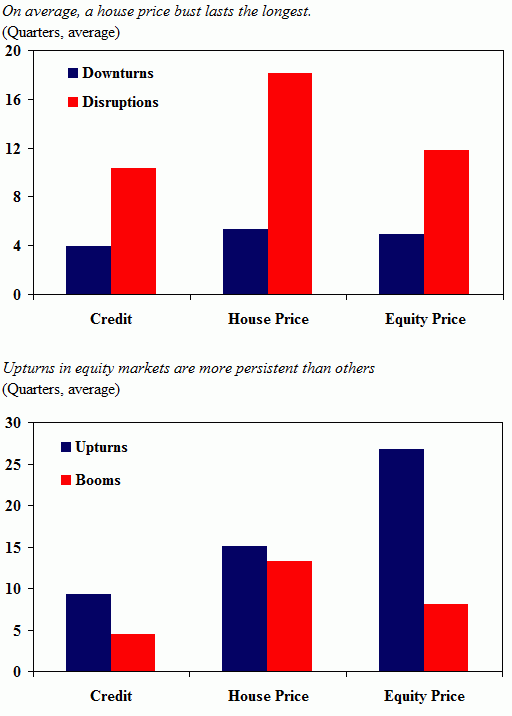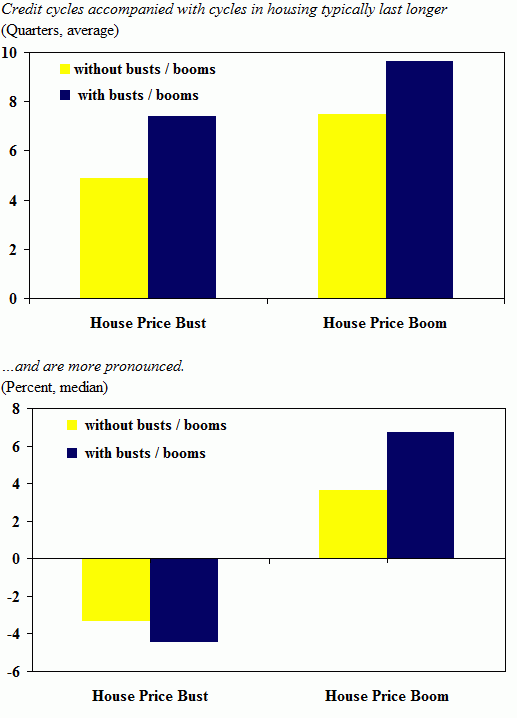Research on the interactions between different types of cycles has produced a number of important policy lessons. Extensive studies of the linkages between inflation cycles and business cycles, for example, have allowed economists to warn of the risk of higher inflation if monetary policy is too lax and the economy is operating above its potential. The recent crisis has shown, however, that the linkages between financial and business cycles are still poorly understood.
The crisis has also led to a re-examination of some of the conventional policy lessons (see Blanchard 2011). In particular, it has led to an extensive debate about how monetary policies should take into account financial outcomes (see Cardarelli et. al. 2008) This debate has emphasised not just the link between inflation and business cycles, but also the importance of improving our understanding of financial cycles and their implications for business cycles.
Previous research on financial cycles has been based mostly on historical narratives rather than systematic analyses. Consequently, some fundamental questions have been left unanswered:
- What are the main features of cycles in financial markets?
- What happens when cycles in different financial markets coincide?
To answer these questions, in recent research we apply the traditional methods of business cycle analysis to a comprehensive database of financial cycles in advanced economies over the 1960-2007 period (Claessens et al. 2011). We exclude from our analysis the years following the recent crisis because a number of financial cycle episodes associated with the crisis are still ongoing.
How to define a financial cycle?
Given that they constitute the core of financial intermediation, we concentrate on cycles in three distinct but interdependent market segments: credit, housing, and equities. In order to characterise financial cycles, we draw parallels between the phases of cyclical fluctuations in output, i.e., business cycles, and those in financial markets. For example, we call the recovery phase of a financial cycle the upturn and the contraction phase the downturn.
In addition to standard cycles, we examine the more intense forms of financial cycles – disruptions and booms – because large movements in financial variables are often associated with highly volatile fluctuations in economic activity. Disruptions include credit crunches and busts in housing and equity markets while booms are simply associated with booms in credit and asset prices.
What are the main features of financial cycles?
Financial cycles can be intense as measured by their amplitude, that is, the decline in real house and equity prices, or real credit volume from peak to trough during downturns and the change in each financial variable during the first four quarters of an upturn (Figure 1).
- Credit crunches, i.e., disruptions in credit markets, are about four times deeper than the average credit downturn, while house price busts are seven times bigger than the average house price downturn.
- In the case of housing markets, swings are typically more asymmetric across the two phases of the cycle: An increase of 11% during booms and a decline of 29% during busts.
Figure 1. Financial cycles across
Source: Claessens, Kose, and Terrones (2011).
Notes: The amplitude of downturns refers to the decline in each variable from its peak to trough. The amplitude of upturns is the change in each variable within the first four quarters after its trough. Disruptions (booms) correspond to the bottom (top) 25% of downturns (upturns) in terms of the amplitude. Downturns (upturns) refer to the episodes other than disruptions (booms).
Moreover, disruptions are often much longer than normal financial downturns (Figure 2).
- The average duration of disruptions ranges between 10 and 18 quarters, with house price busts lasting the longest.
- In contrast, booms tend to be shorter than standard upturns. A typical boom in housing, however, still lasts about 13 quarters.
Figure 2. Disruptions tend to be longer; Booms are often shorter…
Source: Claessens, Kose, and Terrones (2011).
Notes: Duration for downturns is the number of quarters between peak and trough. Duration for upturns is the time it takes to attain the level at the previous peak after the trough. All statistics are sample means. Disruptions (booms) correspond to the bottom (top) 25% of downturns (upturns) in terms of the amplitude. Downturns (upturns) refer to the episodes other than disruptions (booms).
What happens when financial cycles coincide?
What happens when financial cycles coincide? To answer this question, we employ a simple timing rule. We consider a downturn in one financial variable to be associated with a disruption in another if the downturn starts at the same time or shortly after the disruption in the other variable. We employ a similar approach with upturns. Across the various combinations we explore, we find the strongest interactions between credit and housing markets (Figure 3):
- Credit downturns that overlap with house price busts are longer and deeper than other credit downturns.
- When credit upturns coincide with housing booms, they tend to be longer and stronger. These findings are suggestive of the important role that mortgage lending plays in many financial markets.
- Although credit downturns accompanied by equity price downturns are not significantly longer, they tend to be more severe than others. Interestingly, equity cycles seem to be little affected when they are associated with cycles in other financial markets, probably because of the idiosyncratic nature of factors driving fluctuations in equity markets.
Figure 3. Strong interactions between credit and housing markets
Source: Claessens, Kose, and Terrones (2011).
Notes: A credit downturn (or upturn) is accompanied with housing bust (boom), if it starts at the same time or after the beginning of an ongoing episode of the housing episode. The duration refers to the sample mean and the amplitude is the sample median. See notes to Figure 1.
What are the main lessons and policy implications?
Our study takes a first step in exploring financial cycles and documents two major features of these episodes:
- Financial cycles can be long and deep, especially those in housing and equity markets.
- Financial cycles accentuate each other and become magnified, especially during coincident cyclical episodes in credit and housing markets.
Our analysis suggests that it is important to account for the interactions among cycles in different financial market segments when designing regulatory policies aimed at ensuring the overall health of the financial system, especially in terms of the design of macroprudential rules. For example, our results indicate that, as cycles in credit and housing markets tend to enhance each other, if both credit and house prices are growing rapidly, then it might be necessary to employ stricter rules and standards for mortgage lending as well as larger countercyclical buffers to moderate fluctuations in banks’ capital positions.
The views expressed in this column are those of the authors and do not necessarily represent those of the IMF or IMF policy.
References
Blanchard, Olivier (2011), “The future of macroeconomic policy: Nine tentative conclusions”, VoxEU.org, 23 March.
Cardarelli, Roberto, Tommaso Monacelli, Alessandro Rebucci, Luca Sala (2008), “The changing housing cycle and its implications for monetary policy”, VoxEU.org, 26 April.
Claessens, Stijn, M Ayhan Kose, and Marco E Terrones (2011), “Financial Cycles: What? How? When?”in R Clarida and F Giavazzi (eds.), NBER International Seminar in Macroeconomics 2010 (also published as IMF Working Paper No. 11/76).









